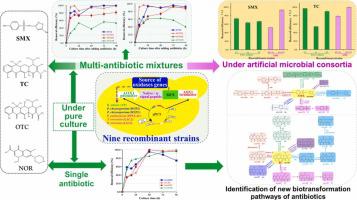Journal of Hazardous Materials ( IF 13.6 ) Pub Date : 2022-07-25 , DOI: 10.1016/j.jhazmat.2022.129674 Shu-Jing Xu 1 , Xin-Yue Chen 1 , Xiao-Feng Wang 1 , Hui-Zhong Sun 1 , Zheng-Jie Hou 1 , Jing-Sheng Cheng 1 , Ying-Jin Yuan 1

|
Antibiotic mixtures in the environment result in the development of bacterial strains with resistance against multiple antibiotics. Oxidases are versatile that can bio-remove antibiotics. Various laccases (LACs), manganese peroxidases (MNPs), and versatile peroxidase (VP) were reconstructed in Pichia pastoris. For the single antibiotics, over 95.0% sulfamethoxazole within 48 h, tetracycline, oxytetracycline, and norfloxacin within 96 h were bio-removed by recombinant VP with α-signal peptide, respectively. In a mixture of the four antibiotics, 80.2% tetracycline and 95.6% oxytetracycline were bio-removed by recombinant MNP2 with native signal peptide (NSP) within 8 h, whereas < 80.0% sulfamethoxazole was bio-removed within 72 h, indicating that signal peptides significantly impacted removal efficiencies of antibiotic mixtures. Regarding mediators for LACs, 2,2′-azino-bis-(3-ethylbenzothiazoline-6-sulfonic acid) resulted in better removal efficiencies of multi-antibiotic mixtures than 1-hydroxybenzotriazole or syringaldehyde. Furthermore, artificial microbial consortia (AMC) producing LAC2 and MNP2 with NSP significantly improved bio-removal efficiency of sulfamethoxazole (95.5%) in four-antibiotic mixtures within 48 h. Tetracycline and oxytetracycline were completely bio-removed by AMC within 48 and 72 h, respectively, indicating that AMC accelerated sulfamethoxazole, tetracycline, and oxytetracycline bio-removals. Additionally, transformation pathways of each antibiotic by recombinant oxidases were proposed. Taken together, this work provides a new strategy to simultaneously remove antibiotic mixtures by AMC.
中文翻译:

产生氧化酶的人工微生物联合体提高了多种抗生素的生物转化效率
环境中的抗生素混合物导致产生对多种抗生素具有抗性的细菌菌株。氧化酶用途广泛,可以生物去除抗生素。在毕赤酵母中重建了各种漆酶 (LAC)、锰过氧化物酶 (MNP) 和多功能过氧化物酶 (VP). 对于单一抗生素,48小时内超过95.0%的磺胺甲恶唑,96小时内的四环素、土霉素和诺氟沙星分别被重组VP与α-信号肽生物去除。在四种抗生素的混合物中,含有天然信号肽 (NSP) 的重组 MNP2 在 8 小时内生物去除了 80.2% 四环素和 95.6% 土霉素,而在 72 小时内生物去除了 < 80.0% 磺胺甲恶唑,表明信号肽显着影响抗生素混合物的去除效率。关于 LACs 的介质,2,2'-azino-bis-(3-ethylbenzothiazolin-6-sulfonic acid) 比 1-羟基苯并三唑或丁香醛具有更好的多抗生素混合物去除效率。此外,使用 NSP 生产 LAC2 和 MNP2 的人工微生物群落 (AMC) 在 48 小时内显着提高了磺胺甲恶唑 (95.5%) 在四种抗生素混合物中的生物去除效率。四环素和土霉素分别在 48 和 72 小时内被 AMC 完全生物去除,表明 AMC 加速了磺胺甲恶唑、四环素和土霉素的生物去除。此外,还提出了重组氧化酶对每种抗生素的转化途径。总之,这项工作提供了一种通过 AMC 同时去除抗生素混合物的新策略。此外,还提出了重组氧化酶对每种抗生素的转化途径。总之,这项工作提供了一种通过 AMC 同时去除抗生素混合物的新策略。此外,还提出了重组氧化酶对每种抗生素的转化途径。总之,这项工作提供了一种通过 AMC 同时去除抗生素混合物的新策略。



























 京公网安备 11010802027423号
京公网安备 11010802027423号